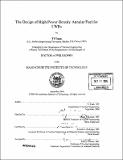The design of high power density annular fuel for LWRs
Author(s)
Yuan, Yi, 1975-
DownloadFull printable version (10.43Mb)
Other Contributors
Massachusetts Institute of Technology. Dept. of Nuclear Engineering.
Advisor
Mujid S. Kazimi.
Terms of use
Metadata
Show full item recordAbstract
Fuel performance models have been developed to assess the performance of internally and externally cooled LWR annular fuel. Such fuel may be operated at 30-50% higher core power density than the current operating LWRs, and to a burnup of 80-100MWd/kgU. The models are used to optimize the fuel design so that it is able to achieve high power density and high burnup, and to identify the features of this fuel that will impact its operation limits. The annular fuel performance codes have been developed based on the NRC licensed FRAPCON-3 code with major modifications to the code structure and with implementation of new fuel performance models. A heat split calculation was enabled by adding a heat flux iteration loop. The radial power peaking and the rim effects at both the inner and outer fuel surfaces have been modeled by a modified radial power/burnup fit to the neutronic calculations. The temperature profile calculation method was updated with new boundary conditions and meshing scheme to capture the internal cooling and the double power peaking at the rims. The annular fuel performance codes are able to simulate both sintered annular fuel and Vibration- Packing (VIPAC) fuel with internal and external cooling. (cont.) For the sintered annular fuel, the anchor ring location of fuel thermal expansion is determined to be the innermost ring, and the fuel dimensions are calculated considering the effects of thermal expansion, swelling and densification. Fuel relocation is assessed via a new empirical model that has been implemented in the code. A fuel cladding mechanical interaction model has been developed with three regimes: the free standing cladding regime, the single closure regime and the fuel cladding full contact regime. The interaction mechanisms for each regime are analyzed and solutions are provided. A low temperature fission gas release model is implemented for sintered annular fuel by taking into account the double surface effects. It is found that the sintered annular fuel rod has lower fission gas release than that of a solid IPWR rod at the same power density. The cladding hydrogen concentration and the oxide accumulation of the annular fuel are comparable to those of the solid fuel due to comparable cladding heat flux and irradiation. Fuel gap conductance asymmetry caused by outward thermal expansion has been identified as a major concern due to its potential effects on NMDNBR. (cont.) A sensitivity study has been performed to evaluate the impact of fuel parameters on fuel performance. The gap asymmetry problem can be circumvented by combining several approaches including: (1) allowing a larger outer gap and a smaller inner gap, (2) enlarging the fuel and cladding surface roughness, and (3) spattering the fuel surface with ZrO₂ particles. The optimized sintered annular fuel shows great potential for achieving high burnup (up to 86MWd/kgU rod average) and operating at 150% power density without compromising fuel safety. A VIPAC annular fuel performance model has also been developed and implemented. An empirical VIPAC fuel thermal conductivity formula has been developed as a function of temperature, burnup, porosity and gas pressure. A fuel-clad interface thermal conductance model has been developed incorporating the effects of fuel particle size, gas pressure and interfacial pressure. The VIPAC fuel bulk dimensional changes have been calculated assuming the same bulk thermal expansion and densification coefficient as the sintered fuel, but the fission product swelling is assumed to be accommodated by porosity. (cont.) The VIPAC fuel- cladding mechanical interaction model applies the full gap closure regime of the pelletized annular fuel model except that fuel cladding "slippage" is assumed. An athermal fission gas release model for VIPAC is developed incorporating the surface and resolution effects of the fuel particles. Compared with the sintered fuel, the gap conductance imbalance problem is completely eliminated for VIPAC fuel but the fission gas release fuel is higher. The VIPAC annular fuel EOL cladding oxide thicknesses and hydrogen concentrations are comparable with those of the sintered annular fuel but the VIPAC annular rod cladding strains are significantly reduced. A sensitivity study of the important parameters of the VIPAC fuel identified that the optimum initial helium gas pressure is within 1.4-2.0 MPa and the optimum particle size is within 300- 600 [mu] m. The optimum smear density is in the range of 85%-90%. A preliminary study of Reactivity Initiated Accidents behavior involving the annular fuel has been made. During a RIA, the annular fuel peak enthalpy is found to be comparable to the solid fuel. However the permanent hoops strain of the sintered annular fuel is lower, and of the VIPAC annular fuel is higher, than that of the solid fuel. (cont.) Analyses of the annular fuel testing at the MIT reactor and planning of the annular fuel post irradiation examination are also presented.
Description
Thesis (Ph. D.)--Massachusetts Institute of Technology, Dept. of Nuclear Engineering, 2004. Includes bibliographical references (p. 189-193).
Date issued
2004Department
Massachusetts Institute of Technology. Department of Nuclear Engineering; Massachusetts Institute of Technology. Department of Nuclear Science and EngineeringPublisher
Massachusetts Institute of Technology
Keywords
Nuclear Engineering.